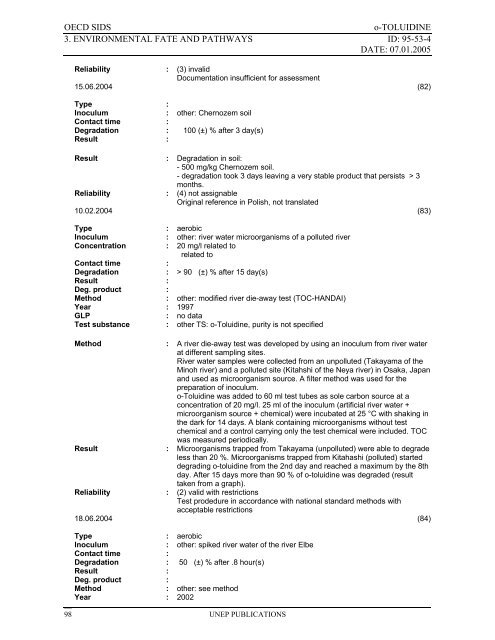o-TOLUIDINE CAS N°: 95-53-4 - UNEP Chemicals
o-TOLUIDINE CAS N°: 95-53-4 - UNEP Chemicals
o-TOLUIDINE CAS N°: 95-53-4 - UNEP Chemicals
You also want an ePaper? Increase the reach of your titles
YUMPU automatically turns print PDFs into web optimized ePapers that Google loves.
OECD SIDS o-<strong>TOLUIDINE</strong><br />
3. ENVIRONMENTAL FATE AND PATHWAYS ID: <strong>95</strong>-<strong>53</strong>-4<br />
DATE: 07.01.2005<br />
98<br />
Reliability : (3) invalid<br />
Documentation insufficient for assessment<br />
15.06.2004 (82)<br />
Type :<br />
Inoculum : other: Chernozem soil<br />
Contact time :<br />
Degradation : 100 (±) % after 3 day(s)<br />
Result :<br />
Result : Degradation in soil:<br />
- 500 mg/kg Chernozem soil.<br />
- degradation took 3 days leaving a very stable product that persists > 3<br />
months.<br />
Reliability : (4) not assignable<br />
Original reference in Polish, not translated<br />
10.02.2004 (83)<br />
Type : aerobic<br />
Inoculum : other: river water microorganisms of a polluted river<br />
Concentration : 20 mg/l related to<br />
related to<br />
Contact time :<br />
Degradation : > 90 (±) % after 15 day(s)<br />
Result :<br />
Deg. product :<br />
Method : other: modified river die-away test (TOC-HANDAI)<br />
Year : 1997<br />
GLP : no data<br />
Test substance : other TS: o-Toluidine, purity is not specified<br />
Method : A river die-away test was developed by using an inoculum from river water<br />
at different sampling sites.<br />
River water samples were collected from an unpolluted (Takayama of the<br />
Minoh river) and a polluted site (Kitahshi of the Neya river) in Osaka, Japan<br />
and used as microorganism source. A filter method was used for the<br />
preparation of inoculum.<br />
o-Toluidine was added to 60 ml test tubes as sole carbon source at a<br />
concentration of 20 mg/l. 25 ml of the inoculum (artificial river water +<br />
microorganism source + chemical) were incubated at 25 °C with shaking in<br />
the dark for 14 days. A blank containing microorganisms without test<br />
chemical and a control carrying only the test chemical were included. TOC<br />
was measured periodically.<br />
Result : Microorganisms trapped from Takayama (unpolluted) were able to degrade<br />
less than 20 %. Microorganisms trapped from Kitahashi (polluted) started<br />
degrading o-toluidine from the 2nd day and reached a maximum by the 8th<br />
day. After 15 days more than 90 % of o-toluidine was degraded (result<br />
taken from a graph).<br />
Reliability : (2) valid with restrictions<br />
Test prodedure in accordance with national standard methods with<br />
acceptable restrictions<br />
18.06.2004 (84)<br />
Type : aerobic<br />
Inoculum : other: spiked river water of the river Elbe<br />
Contact time :<br />
Degradation : 50 (±) % after .8 hour(s)<br />
Result :<br />
Deg. product :<br />
Method : other: see method<br />
Year : 2002<br />
<strong>UNEP</strong> PUBLICATIONS
















